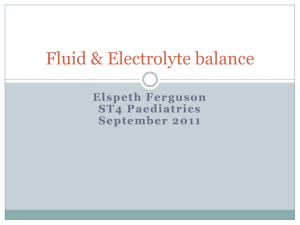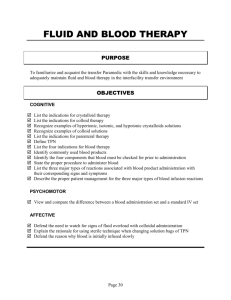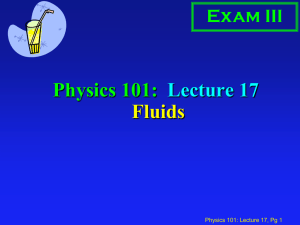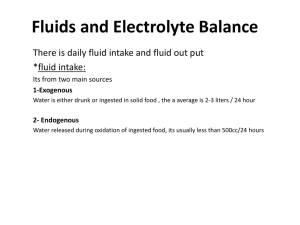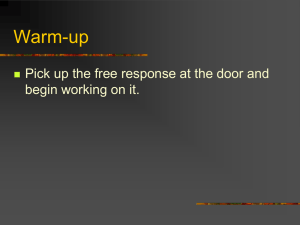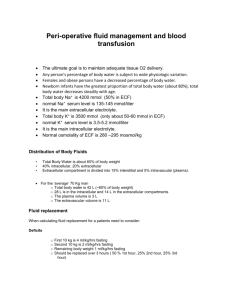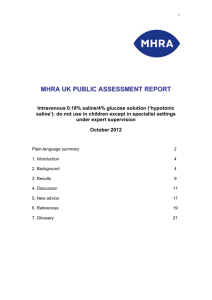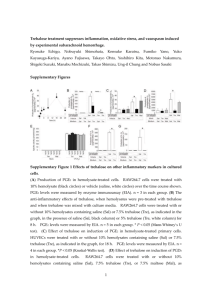Perioperative Management 1: fluid balance
advertisement
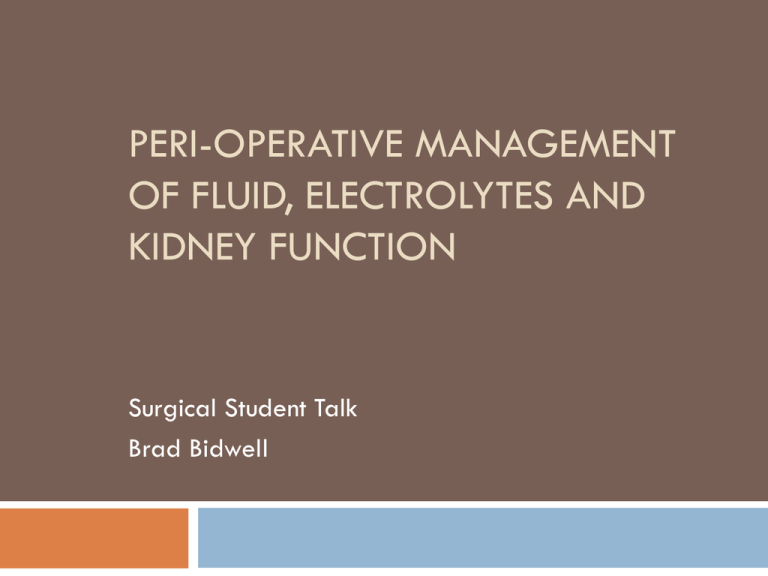
PERI-OPERATIVE MANAGEMENT OF FLUID, ELECTROLYTES AND KIDNEY FUNCTION Surgical Student Talk Brad Bidwell If you take away one point from today it should be this: There is no magic formula for fluid management, it depends on the patient and the situation, if in doubt then asks someone more senior Where is it all going? Extracellular (1/3) Sodium rich, potassium poor Total body water Intravascular (1/3) Interstitial (2/3) Intracellular (2/3) Potassium rich, sodium poor Assessing Fluid Balance Urine output Peripheral circulation JVP Postural blood pressure Lung sounds Oedema Thirst Heart rate, blood pressure, mucous membranes, tissue turgor, weight Assessing Kidney function Urine output UECs Especially creatinine and urea Categories of Fluids Maintenance fluids Daily requirements Ongoing losses “Surgical” losses: bleeding, serous ooze, drain tube losses – these tend to be sodium rich Gastrointestinal losses: vomiting, diarrhoea, nasogastric losses – these tend to be potassium rich Resuscitation fluids (replacement of losses) What is needed each day? Water 4:2:1 rule: (4ml/kg/hr for the first 10kg body weight PLUS 2ml/kg/hr for 11-20kg of body weight PLUS 1ml/kg/hr for every kg of body weight after that) For a 70kg pt: (40 + 20 + 50 = 110mL/hr = 2640 mL/day) Monitor by maintaining urine output in the range of 0.5 1.0mL/kg/hr (i.e. 35 – 70 mL/hr) Sodium 1 – 2 mmol/kg/day (i.e. 70 – 140 mmol/day) Potassium 0.5 – 1 mmol/kg/day (i.e. 35 – 70 mmol/day) Types of Fluids Crystalloid Electrolytes dissolved in water E.g. normal saline, CSL/Hartmann’s, 5% dextrose, 4% dextrose + 1/5th normal saline (“4 and 1/5th) Colloid Large molecules dissolved in water E.g. gelofusine, albumin Blood products E.g. PRBCs, FFP, platelets Crystalloids Normal Saline 150mmol Na+ Hartmann’s Solution (CSL) 131mmol Na+ 111mmol Cl- 150mmol Cl- 30mmol Na+ 50g dextrose 30mmol Cl- 29mmol lactate 5mmol K+ 4mmol Ca2+ 1L Water 5% Dextrose 1L water 4% dextrose and 1/5th normal saline 40g dextrose 1L water 1L water You can add other electrolytes to these bags! Rate of fluids Fluids come in 1 L bags You write it up as how fast you want to give that bag Write up 24 hours worth of fluids, and make sure they’re not finishing overnight Average sized, middle aged patient Small, frail, elderly patient Will require more fluid than the average patient Regular fluid requirements Won’t need much fluid, too much fluid will overload their heart 8/24 10/24 12/24 Big, fit young patient The Real World Check the history: CCF? Renal failure? Haemorrhage? What restriction are they on? How much fluid have they had already? Fluid assess the patient: Does the patient look well? Are they thirsty? Check the obs, especially BP and urine output. Listen to the lungs, check for sacral oedema. Check the tests: Are their electrolytes in normal range and is their kidney function good CXR? The Autopilot Method What people usually do: N.saline 8/24 N.saline 8/24 N.saline 8/24 The electrolyte load from this is: 3L of water per day 450 mmol Na+ per day 0 mmol K+ per day The 70kg patient needs: 2.6L of water per day 70 - 140mmol Na+ per day 35 - 70mmol Na+ per day The Autopilot Method Try this: + 1/5th, with 30mmol K+ added 4% + 1/5th, with 30mmol K+ added 4% + 1/5th 4% This gives: 3L water per day 90mmol Na+ per day 60mmol K+ per day 8/24 8/24 8/24 Case study 1 HOPC: 28 F presents to ED with 3/7 of poorly localised central abdominal pain, increasing in intensity and shifting to the RIF over the last 12/24. Nil fevers, nil changes to bowels/urine, nausea but no vomiting. Virgin abdomen. No significant PMHx. O/E: Obs stable, afebrile abdomen soft with focal tenderness in RIF and voluntary guarding. Pain worse when the right hip is flexed. Ix: FBE – mildly elevated WCC, UECs – NAD, LFTs/lipase NAD, CRP 50, B-HCG negative Dx: clinically acute appendicitis Mx: Fasting, for theatre – lap. Appendicectomy The registrar tells you to write up some fluids. What do you give? Case study 2 Hx: 78 M 3/7 cramping abdominal pain with nausea and vomiting. Hasn’t opened bowels in 2/7. No fevers, no urinary changes. PMHx – some operation on abdomen 40 years ago, mild “heart troubles”, AF – on warfarin, high cholesterol. O/E: Obs: HR 105, BP 110/70, abdomen soft, generalised tenderness, midline laparotomy scar visible superior to umbilicus Ix: FBE – NAD, UECs – Na 138 K 3.5 Dx: likely SBO Mx: CT A/P, trial conservative management – nasogastric and IV fluids The registrar tells you to write up some fluids. What do you give? Case study 3 Hx: 52 M presents to ED with a poor thrill in his AV fistula. PMHx – ESRF due to poorly controlled T2DM, currently on haemodialysis 3x weekly, 1L fluid restriction per day, 2 prior AMI’s – stents, on warfarin, PVD – right BKA, HTN … O/E: Obs – stable (BP 165/130), afebrile. No thrill over AVF site, no bruit heard. Ix: FBE – NAD, UECs – Cr 450, Ur 20.3, K+ 6.2 Dx: blocked fistula Mx: unblock fistula The registrar tells you to write up some fluids. What do you give? Calcium, Magnesium, Phosphate Usually we don’t worry about these too much, especially in patients fasting for a short amount of time Treat to target – usually we don’t prescribe regular CMP supplements, we replace in response to the test Supplementation Electrolyte Medication K+ 3.0-3.5 Dose Route Frequency Speed Chlorvescent 2-4 tabs oral STAT rapid Slow K 1-2 tabs oral Daily/bd slow KCl 30mmol IV In 1L N.saline over x/24 rapid K+ < 3.0 KCl 10mmol IV In 100mL N.saline over 1/24 rapid Mg < 0.75 Magmin 2 tabs oral STAT slow Mg < 0.65 MgSO4 10mmol IV In 100mL N.saline over 1/24 rapid PO4 < 0.8 Phos. Sandoz 2-3 tabs oral STAT slow PO4 < 0.6 PO4 13.4mmol IV In 100mL N.saline over 4/24 rapid Resuscitation Ascertain where the losses are from: Blood? Dehydration? Vomiting or diarrhoea? Replace like with like (i.e. if they’ve lost blood, give them blood). Haemorrhagic Shock Class Blood loss HR BP Urine Out. RR I <15 % (750 mL) < 100 Normal > 30mL/hr 14 - 20 15 - 30 mL/hr 21 - 30 II 15-30 % (750 mL -1500 mL) 5-15 mL/hr 31-40 III 30-40 % (1500 mL – 200mL) None > 40 IV >40 %(> 2000 mL) > 100 > 120 > 140 Decreased Decreased Decreased Replacing Massive Blood Loss Control the bleeding 1L of normal saline STAT, followed by a second bag if necessary. If patient is still unstable, blood products are necessary at this point Group and screen, crossmatch RMH has a “massive exsanguination pack” – O negative blood products ready to go in a cooler. Traps Beware third spacing conditions – ascites, pleural effusion, pancreatitis, burns Pay close attention to old, frail patients Monitor patients closely when giving large amounts of N.saline Ignoring CMP’s in patients who are fasting for a longer period – treat to target References Fluid Management Student BMJ 2010;18:c5063 http://student.bmj.com/student/viewarticle.html?id=sbmj.c5063 “Maintenance” IV fluids in euvolaemic adults, Michael Tam http://vitualis.wordpress.com/2006/05/01/mainte nance-iv-fluids-in-euvolaemic-adults/ OHCM Toronto Notes
